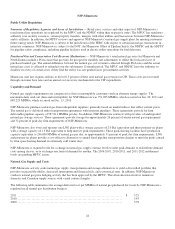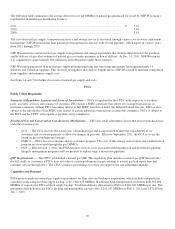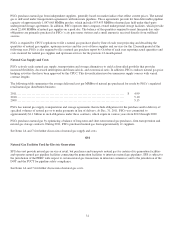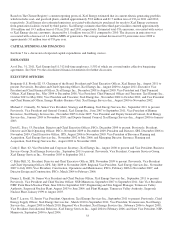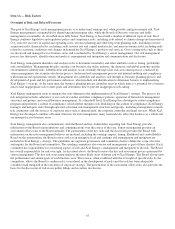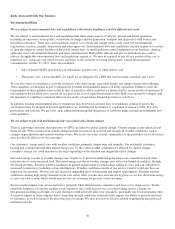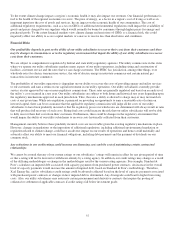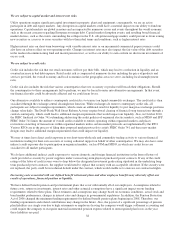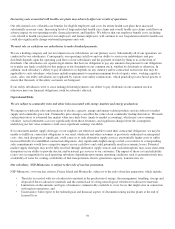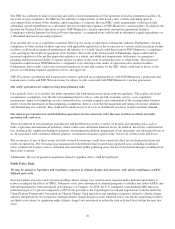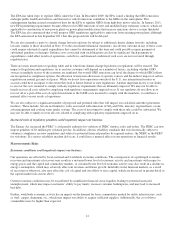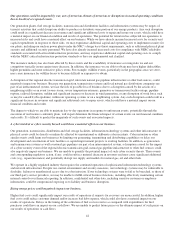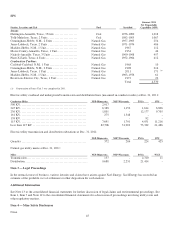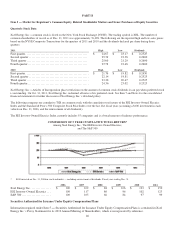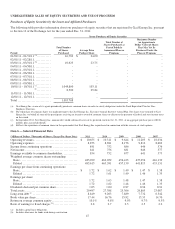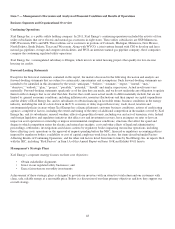Xcel Energy 2011 Annual Report Download - page 48
Download and view the complete annual report
Please find page 48 of the 2011 Xcel Energy annual report below. You can navigate through the pages in the report by either clicking on the pages listed below, or by using the keyword search tool below to find specific information within the annual report.38
We are subject to capital market and interest rate risks.
Utility operations require significant capital investment in property, plant and equipment; consequently, we are an active
participant in debt and equity markets. Any disruption in capital markets could have a material impact on our ability to fund our
operations. Capital markets are global in nature and are impacted by numerous issues and events throughout the world economy,
such as the recent concerns regarding European sovereign debt. Capital market disruption events, and resulting broad financial
market distress, such as the events surrounding the collapse in the U.S. sub-prime mortgage market, could prevent us from issuing
new securities or cause us to issue securities with less than ideal terms and conditions, such as higher interest rates.
Higher interest rates on short-term borrowings with variable interest rates or on incremental commercial paper issuances could
also have an adverse effect on our operating results. Changes in interest rates may also impact the fair value of the debt securities
in the nuclear decommissioning fund and master pension trust, as well as our ability to earn a return on short-term investments of
excess cash.
We are subject to credit risks.
Credit risk includes the risk that our retail customers will not pay their bills, which may lead to a reduction in liquidity and an
eventual increase in bad debt expense. Retail credit risk is comprised of numerous factors including the price of products and
services provided, the overall economy and local economies in the geographic areas we serve, including local unemployment
rates.
Credit risk also includes the risk that various counterparties that owe us money or product will breach their obligations. Should
the counterparties to these arrangements fail to perform, we may be forced to enter into alternative arrangements. In that event,
our financial results could be adversely affected and we could incur losses.
One alternative available to address counterparty credit risk is to transact on liquid commodity exchanges. The credit risk is then
socialized through the exchange central clearinghouse function. While exchanges do remove counterparty credit risk, all
participants are subject to margin requirements, which create an additional need for liquidity to post margin as exchange positions
change value daily. The Dodd-Frank Wall Street Reform Act may require broad clearing of financial swap transactions through a
central counterparty, which could lead to additional margin requirements that would impact our liquidity. Also, in October 2010,
the FERC finalized its Order 741 rulemaking addressing the credit policies of organized electric markets, such as MISO and SPP.
FERC Order 741 limits the amount of overall credit available to entities operating within organized markets and places
restrictions on netting of transactions within organized markets unless certain market protocols are implemented by the RTO.
Various RTOs are in the process of filing their proposed market protocols to satisfy FERC Order 741 and these new market
designs may lead to additional margin requirements that could impact our liquidity.
We may at times have direct credit exposure in our short-term wholesale and commodity trading activity to various financial
institutions trading for their own accounts or issuing collateral support on behalf of other counterparties. We may also have some
indirect credit exposure due to participation in organized markets, such as PJM and MISO, in which any credit losses are
socialized to all market participants.
We do have additional indirect credit exposures to various domestic and foreign financial institutions in the form of letters of
credit provided as security by power suppliers under various long-term physical purchased power contracts. If any of the credit
ratings of the letter of credit issuers were to drop below the designated investment grade rating stipulated in the underlying long-
term purchased power contracts, the supplier would need to replace that security with an acceptable substitute. If the security were
not replaced, the party could be in technical default under the contract, which would enable us to exercise our contractual rights.
Increasing costs associated with our defined benefit retirement plans and other employee benefits may adversely affect our
results of operations, financial position or liquidity.
We have defined benefit pension and postretirement plans that cover substantially all of our employees. Assumptions related to
future costs, return on investments, interest rates and other actuarial assumptions have a significant impact on our funding
requirements related to these plans. These estimates and assumptions may change based on economic conditions, actual stock and
bond market performance, changes in interest rates and changes in governmental regulations. In addition, the Pension Protection
Act of 2006 changed the minimum funding requirements for defined benefit pension plans beginning in 2008. Therefore, our
funding requirements and related contributions may change in the future. Also, the payout of a significant percentage of pension
plan liabilities in a single year due to high retirements or employees leaving the company would trigger settlement accounting and
could require the company to recognize material incremental pension expense related to unrecognized plan losses in the year
these liabilities are paid.


